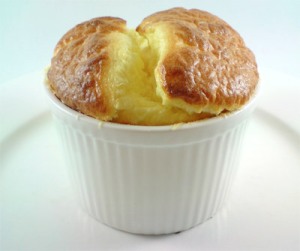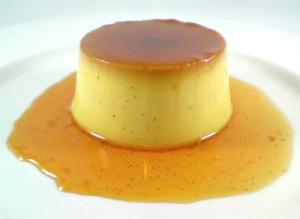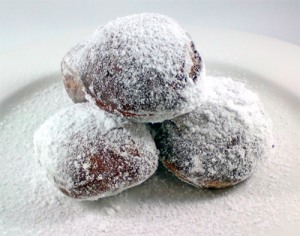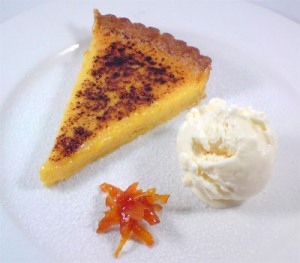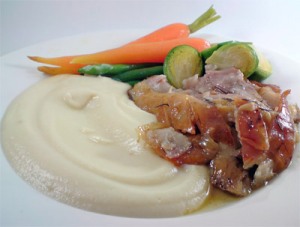The following are resources I have referenced:
Preserved Cumquats
500g cumquats + water
625g sugar
1 cup water
Prick the cumquats just once with a skewer. Bring 3 cups water to the boil, add the cumquats and gently simmer for 10 minutes. Drain.
Place the sugar and cup of water in a saucepan and bring to the boil then boil for 20 minutes. Add the cumquats and boil for 15 minutes.
Serving suggestion: serve with blue cheese as a savoury taste sensation, or more traditionally with ice cream for a dessert.
http://blogs.abc.net.au/nsw/2009/06/the-knack-of-cumquats.html
——————————————————————————————————————————————————————————–
Candied Kumquats
100 grams sugar
100 grams water
1/2 vanilla bean, split and seeded
1 pint of kumquats
Bring some water to a boil in a small saucepan (enough to cover the kumquats) and add the kumquats. Blanch them for about 30 seconds and drain them. Discard the water. Repeat the process two more times. This will eliminate any bitterness from the kumquats.
Make a simple syrup with the first three ingredients by bringing them to a boil in a small saucepan. Add the blanched kumquats and simmer for about 15 minutes in low heat. You can drain them, let them dry and coat them in sugar or you can store them in the simple syrup in the refrigerator.
http://cannelle-vanille.blogspot.com/2009/01/candied-kumquat-and-pistachio.html
——————————————————————————————————————————————————————————–
“Kumquat Preserves from Christine Mansfield’s Desserts. I’d never made any sort of preserves. The process was long, but fairly simple. You soak the fruit and seeds in water overnight, boil them for a while, let the mixture rest, and then boil it again until it sets a bit. This stuff is killer- I will try and take a picture of the finished product when I crack open a jar .”
http://pghtasted.blogspot.com/2007/03/experimenting.html
——————————————————————————————————————————————————————————–
The following is a response from Bodega Tapas when I asked them how they prepare their cumquats: “Cut the cumquats in half and boil in water until the skin is soft. Drain the water. Add new water and sugar to the cumquats. (The mix must be 60% sugar to preserve the cumquats for longer). Reduce the mixture over a low heat”.
——————————————————————————————————————————————————————————–
Candied Kumquats
2 cups water
2 cups sugar
1 vanilla bean, split lengthwise
9 ounces kumquats (about 25 medium), thinly sliced crosswise, seeds removed
Combine water and sugar in medium saucepan. Scrape in seeds from vanilla bean; add bean. Stir over medium heat until sugar dissolves. Add kumquats; reduce heat. Simmer until kumquat slices are translucent, about 25 minutes. Remove from heat; cool kumquats in syrup. Strain kumquats, reserving syrup. Combine kumquats and 1/4 cup syrup in small bowl. Return remaining syrup to same saucepan; boil until reduced to 1 & 1/4 cups, about 8 minutes.
http://epicurious.com/recipes/food/views/Orange-Cheesecake-with-Candied-Kumquats-240424
——————————————————————————————————————————————————————————–
Tracy Rutherford’s Spiced Cumquats
1kg cumquats
1/2 cups (330g) caster sugar
1/2 cup (125mL) water
1 cinnamon stick
6 lightly crushed cardamom pods
1 teaspoon fennel seeds
1 teaspoon coriander seeds
1. Halve the cumquats lengthways and prise out any pips. Combine the sugar, water and cumquats in a large saucepan and stir over low heat, without boiling, until the sugar has dissolved.
2. Add the spices, stir to combine. Cover and bring to the boil over medium-high heat, then reduce the heat slightly and simmer for 10 minutes. Spoon into sterilised jars (2 x 500mL or 4 x 250mL) and seal tightly. Store in a cool, dark place for up to 6 months. Refrigerate after opening, and use within 6 weeks.
Note: these are great with roast duck or pork.
Cumquat Marmalade
2 cups cumquats, washed and sliced
2 cups water
juice of 1 lemon
2 cups sugar
- Wash and slice fruit finely and remove seeds (but don’t throw the seeds away).
- Place the fruit in a large saucepan, cover with water and soak overnight (or for around 8 hours). Put the seeds in a separate container (such as a cup) and soak in a small amount of boiling water. Leave overnight.
- Next day strain the liquid from the seeds. Discard the seeds and add the water to the cumquats. Cook gently on a low heat until the fruit is tender and the liquid is reduced by half.
- Add the sugar and lemon juice. When all the sugar has dissolved, turn up the heat and boil rapidly until the mixture jells (around 30-45 minutes). Tip: stir often, or the marmalade will burn!
- To test if the marmalade is jelling, spoon a little onto a cold saucer. If a skin forms, and it glazes on the surface and wrinkles when touched, it is ready. If it is still runny, boil for a little longer and test again.
- Pour into hot sterilised jars and seal.
Cumquat brandy
750g cumquats
500g caster sugar
750mL bottle brandy
sterilised 1-litre sealable jar
Wash and dry the cumquats, the prick each of them several times with a fine skewer or needle. Place a layer of cumquats in the jar, then sprinkle with sugar. Arrange another layer of cumquats, sprinkle with more sugar, and keep on doing this until you have used up all the cumquats and sugar. Now pour the brandy over the cumquats (you probably won’t use all of the brandy), seal the jar and place in a dry dark place, such as a cupboard. For the first week, turn over the jar once each day to help dissolve the sugar. Then, after that, turn over the jar once a week to keep on mixing things up. The whole thing should be ready in three months. The idea is that you can eat the cumquats and drink the brandy, too!
For a sweeter result, use more sugar, but don’t use less. The cumquats are fairly tart, so they’ll be hard to eat with less sugar used.
http://burkesbackyard.com.au/factsheets/Food-Health-and-Nutrition/Cumquat-recipes/3107
——————————————————————————————————————————————————————————–
http://gourmettraveller.com.au/ricotta_and_semolina_budino_with_candied_cumquats.htm
——————————————————————————————————————————————————————————–
http://gourmettraveller.com.au/semolina_porridge_with_candied_cumquats.htm
——————————————————————————————————————————————————————————–
http://gourmettraveller.com.au/gin_and_lime_tart_with_confit_cumquats.htm
——————————————————————————————————————————————————————————–
Masterchef Australia on Ten
Oranges are cut into pieces, placed in a saucepan, covered with caster sugar then some water and brought to the boil, then allowed to cool, then brought back up to the boil and then cooled again to make candied orange.
http://www.masterchef.com.au/video.htm?vxSiteId=fefcb37d-8e38-4dbc-a768-e8bb503ed226&vxChannel=CatchUpTV&vxClipId=2664_215MCTT130509&vxBitrate=300&vxTemplate=MasterChef_Index.swf&vxClickToPlay=false
——————————————————————————————————————————————————————————–
Read Full Post »
